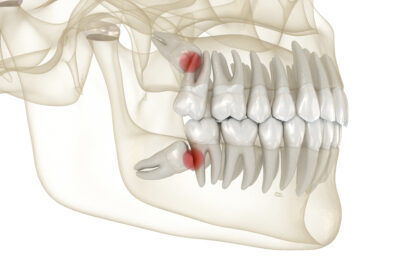When you think about it, wisdom teeth seem like an exercise in poor design. The average human jaw can comfortably accommodate 28 permanent teeth. Yet, sometime around the college years, four additional teeth try to squeeze in there. So, why develop wisdom teeth at all? Today, Cerritos, CA dentist and oral surgery expert, Dr. Shawn Hofkes, answers this question and shares some fascinating facts about these problematic teeth.
Why Do You Have Third Molars in the First Place?
Scientists point out that our early ancestors underwent some dramatic dietary changes as they evolved. The earliest humans used their teeth to consume a diet of roots, leaves, and raw meat; thus, it made sense to have a third set of sturdy back teeth to help chew these rough, fibrous foods. However, as we evolved into tool-using, fire-building, upright-walking humans, we began to process and cook our food, making it much easier to eat. The fossil record even shows that modern human jaws are remarkably smaller than primitive human jaws yet, in a strange twist of evolutionary fate, we still develop those four additional, mostly useless wisdom teeth.
When Wisdom Teeth Go Bad
When a third molar does not fully erupt, it is classified as impacted. Estimates show that 65-72% of people have at least one impacted wisdom tooth and, interestingly, not all impactions are created equally. Just a few ways a third molar can be impacted include:
- Mesial. The third molars develop at an angle, toward the anterior (front) of the mouth.
- Vertical. The wisdom teeth are positioned like your other teeth, without any angulation.
- Horizontal. As the name suggests, these develop on their side, with the crown pointing toward either the front or back of the mouth.
- Distal. The molars are angled toward the posterior (back) of the mouth.
- Soft-tissue. The molar’s crown (the top, normally visible portion of the tooth) has not fully erupted from the gums.
- Bony. The wisdom tooth has failed to emerge from the jaw bone. “Full” bony impactions have not emerged at all, while “partial” bony impactions have erupted from the bone in part.
Some oral health problems associated with impacted wisdom teeth include inflamed and sensitive gum tissue covering or surrounding the wisdom tooth, especially in cases of soft tissue impactions; overcrowding of the other teeth, which can lead to an increased risk for decay and gum disease, as well as esthetic concerns; decay, gum disease, and infection in the area around the wisdom tooth; and, if infection leads to cyst formation around the wisdom tooth, permanent damage the jaw bone tissue could occur.
Should Wisdom Teeth be Removed?
As with all major dental procedures, wisdom tooth extraction depends on several factors. First, your dentist will use digital x-rays to determine whether any of your wisdom teeth are impacted. If you do have an impaction, your dentist can then make an educated guess as to whether or not that impaction will result in further oral health problems. Of course, if you notice frequent pain, sensitivity, or swelling at the back of the dental arch, you should schedule an appointment with your regular dentist or a dentist with advanced training in wisdom teeth extraction.
About Shawn Hofkes, DDS
With advanced training in oral and maxillofacial surgery and certification in sedation dentistry, Shawn Hofkes, DDS has years of experience performing safe, comfortable wisdom tooth extractions from our comfortable, state-of-the-art dentist office in Cerritos, CA. To schedule your appointment or consultation with Dr. Hofkes, contact us today. We proudly serve patients of all ages from Cerritos, Lakewood, Long Beach, Buena Park, and all surrounding communities.














